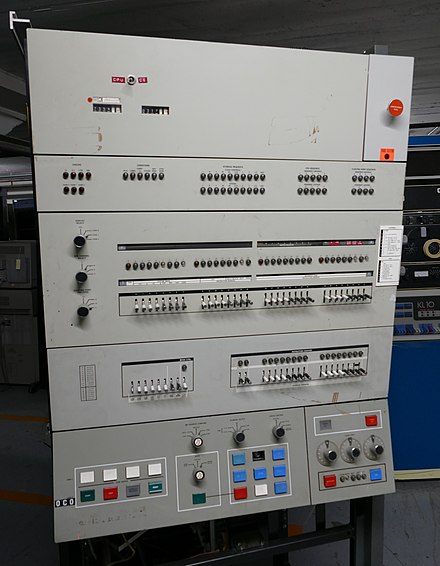These memories of mine refer to the time when the first computer for the Mathematical Institute was procured and the first computing centre was formed at the Institute. First, let us look at what the computer environment was like in the 1960s. Larger companies procured smaller systems for accounting and business applications. These were the card systems of IBM and UNIVAC. At the request of the Rocket Institute, I solved a system of nine nonlinear algebraic equations on such a system; it was a computer with an external program UNIVAC 60. The biggest computer systems were IBM's card systems in the Republic and Federal Statistical Offices. There was an IBM 705 system in the Federal Statistical Office. Using this system, I worked on a program for designing electric motors for the “Rade Končar” Factory in Zagreb. Among the computers for scientific and technical calculations, there were the computers CER-11, ELLIOTT 803B and Zuse. Few people have ever heard of CER-11. It was a computer made in 1963 at the “Mihailo Pupin” Institute for the needs of a military institute. I participated in creating its preliminary design and as far as its architecture was concerned, it was a computer of the IBM 705 rank. There were more Eliot computers. I used one at “Energoprojekt” company and the other at the Institute of Transportation. Zuse computer was interesting because the magnetic drum was used as a unique memory. I also worked on it, and it was at the Rocket Institute. What all these computers have in common is that they used paper tape to enter data and programs.
In such a computer environment, in 1968, the Mathematical Institute received funds for the purchase of computers for scientific and technical calculations. As the Institute did not have premises for the accommodation of the system and the organisation of the computing centre, it was decided that the centre be organised at the Faculty of Science and Mathematics, and I was appointed head of the Computing Centre. The staff of the Centre were employees of the Mathematical Institute, and it was agreed that the Faculty of Science and Mathematics would be able to use the Centre free of charge for the needs of computer science teaching.
And it was time to choose the company from which the system will be purchased. IBM was chosen as the largest computer manufacturer at the time, and which owned computers for scientific and technical applications in its 360 series. An IBM 360/44 computer is selected. It was, at the time, a very advanced computer in Europe installed only in Cambridge, Dortmund and Vienna.
Then, for the first time, we were in the position to use the computer in a broader range of training. It is natural to consider which medium is the most suitable for entering programs and data into the computer. The choice is not wide since it can only be a paper tape or a card. The advantage of using a paper tape is that the order of program and data commands cannot be physically changed by the user, while in the case of a card it can be easily changed by carelessness and make both the program and data meaningless. However, in the case of training, the problem of correcting errors in the program and data must be kept in mind. This is very difficult to do when you are using a tape, while in the case of a card it is very simple. Thus, it was concluded that it should be a card system, which IBM was using broadly in its systems. The problem concerning the input medium would be adequately solved with the advent of terminals and personal computers.
Technical characteristics of the IBM 360/44 system
IBM launched the 360 series of computers in 1964, and the first Model 44 computer was produced in 1965. The computer was announced as a system for scientific and technical applications and process management. Here are the characteristics of our system configuration:
- The internal memory could be selected between 8,192, 16,384, and 32,768 words. Our system had 16,384 words. A word contained 4 bytes, so it had 36 bits, of which 32 were for data and 4 bits for parity control. The very important thing was that the memory was with parallel read and write and not serial, byte by byte. Memory access time was 1µs. Later, the system was expanded to 32,768 words.
- The arithmetic and command unit contains 16 general registers intended for performing arithmetic operations (battery) and addressing methods (index registers). Arithmetic operations were performed on integers; addition and subtraction speeds were 1.75µ and floating point single and double accuracy. Single accuracy was 32 bits and addition and subtraction speeds were 3.81µ, while double accuracy was 64 bits with a speed of 6.32µs for addition and subtraction, and up to 140µs for multiplication and division.
- Peripherals consisted of external memory, input, and output units. The communication of the central unit with the periphery was performed through two channels: a fast channel with the speed of 200,000 z/s and a standard channel with a speed of 50,000 z/s. Two disk units with a capacity of 1,088Kb, each with an average access time of 70ms, were connected to the fast channel. Later, two more disks with a capacity of 7,250Kb each were added. A card reader and puncher and a parallel printer were connected to the standard channel. The speed of the card reader was 1,000 rpm, and the speed of the puncher was 300 rpm. The parallel printer had a speed of 600 lines per minute, where each line could have 120 typographic characters. A plotter was later added to this configuration.
- As far as the software was concerned, the system had an operating system, a FORTRAN compiler, and a subprogram library. The existence of FORTRAN has significantly improved the teaching of programming and enabled a wider circle of people to engage in programming.
At that time, this configuration represented the cutting-edge of computer equipment for scientific and technical calculations. The improvement of teaching computer science and numerical mathematics is especially important. Until then, students were trained to use simple mechanical calculators on which they performed one arithmetic operation at a time. From that position, we moved onto the level of problem algorithmisation, and even the most complex algorithms are easily transferred and implemented on a computer.
The Computing Centre Activities
I think that the official opening of the Centre was at the end of 1968, but, if I am wrong, maybe at the beginning of 1969. We printed invitations and distributed them to various faculties and institutes, our potential users of the system, so we thought. Professor Đuro Kurepa delivered a speech at the opening, and then I spoke about the configuration of the system and the future work of the Centre. It is difficult to remember those first days now, but I had an interview for a paper called IT NOVINE (No. 314, March 14, 1969). For that reason, it would be best to quote what I said for that paper about the functioning of the Centre:
“Besides performing tasks for the Institute and the Faculty of Natural Sciences and Mathematics, we have already signed about twenty contracts with various users, and several contracts are about to be signed. The range of problems that we should solve is very diverse. Some service users have mathematically complex problems that cannot be solved with a pen and paper. Belgrade Agricultural Combine solved several problems in linear programming in the Centre, and tasks of solving problems with several hundred variables were announced. As we have been told, a very interesting problem is being solved for the “Jaroslav Černi” Institute, about the simulation of the Morava River basin. The “Mihailo Pupin” Institute is interested in solving the problem of simulation of various devices and projects, which have practically not been realised yet, while a large number of calculations have been solved for the Federal Bureau of Measures and Precious Metals. Although these calculations are routine in nature, the work on them would not be worthwhile without mechanographic means due to their volume.
Even though the Centre practically started functioning at the beginning of this year, it performs mass processing of statistical data for the Federal Hydrometeorological Institute in addition to all other tasks. Just to mention some more activities, we are working on the development of new numerical procedures and problems in the theoretical field of physics, for which the Institute of Physics and the “Boris Kidrič” Institute are interested. Among the interesting applications, we should mention the cooperation with the Biological Institute, on solving the problem of identification of biological processes and on the simulation of nervous systems.
We want to gather a number of regular users of our services with whom we would develop close cooperation, not only in the practical application of computers, but also in theoretical research.”
The last I said in the interview became my constant inclination for the Centre’s associates to participate as collaborators of various research teams. This is best confirmed by the fact that the associate, who worked for the Mining Institute, and with whom we cooperated extremely well, defended his doctoral thesis at the Faculty of Mining and Geology. In addition, an associate who worked for the Faculty of Civil Engineering defended his doctoral thesis at that faculty. The vast majority of the Centre’s associates have a master's degree and a doctorate in addition to their regular work at the Centre. I think that in every research team in this country, no matter what the field they work in, there should be one mathematician. Mathematicians need to be able to use computers and the mathematical apparatus creatively and do so in a variety of research situations.
The Computing Centre worked for over 10 years, and then there was a period of greater procurement of computers by our users, thus our system became obsolete and increasingly served for students’ training and less for research. Thus, the system passed under the full jurisdiction of the Faculty of Science and Mathematics and all associates of the Centre moved to the Faculty, and the Centre was renamed the Computing Laboratory. Finally, systems with terminals arrived, and IBM 360/44 completed its mission at the Museum of Science and Technology in Belgrade.

IBM 360/44, download from Internet

